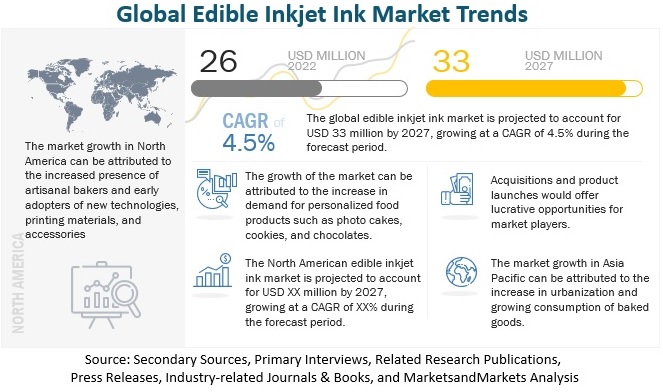
The edible inkjet ink market is projected to reach from 26 million in 2022 to USD 33 million by 2027, growing at a CAGR of 4.5% from 2022 to 2027. Rapid urbanization has brought about lifestyle changes that have significantly altered the traditional consumption patterns of consumers worldwide. The new generation and younger consumers are inclined towards individualized experience and are willing to spend more for customized food products or services. Edible inkjet inks are used in the bakery and confectionery industries by food manufacturers to customize conventional bakery, confectionery, and snack items by imprinting pre-printed images with edible food colors. The growth in innovations with respect to conventional food items and advancements in digital printing technology are propelling the market expansion for edible inkjet ink.
Download PDF brochure: https://www.marketsandmarkets.com/pdfdownloadNew.asp?id=4751803
The bakery industry is witnessing steady growth globally and, more specifically, in developing countries. Bakery products are gaining traction owing to their increasing nutrient value and affordability. Moreover, in developing countries, the increasing female working population, the growing influence of foreign trends, and changing consumer eating habits drive the demand for bakery goods. The COVID-19 pandemic has also resulted in the rising consumption of bakery products, primarily the products with healthy ingredients, products with unique flavors, and diet-friendly products. Rising consumer income, increasing expansion, and the presence of bakery retail outlets such as supermarkets and hypermarkets accelerate the retail performance of bakeries in countries such as India, China, and Japan.
Food items may get contaminated by ink migration when harmful non-food-grade ink is used on food packaging instead of edible inkjet ink. This is a significant concern, especially in food products like tablets, capsules, and baby foods. Ink migration occurs when ink components from the packing material infiltrate food. In addition to contaminating food, ink migration can alter the taste and odor of food, pose harmful effects on customer health, and compromise the reputation of the company. According to the WHO, contaminated food causes an estimated 600 million illnesses and 420,000 deaths worldwide each year, costing 33 million years of healthy life. Furthermore, an upsurge in norovirus cases was observed in Slovenia in December 2021 due to possible contaminated packaging. Non-food-grade ink migration may thus act as a challenge in the growth of the edible inkjet ink market.
Make an Inquiry: https://www.marketsandmarkets.com/Enquiry_Before_BuyingNew.asp?id=4751803
North America is the one of the key contributors when it comes to development and application of new technologies. The well-developed manufacturing industry, availability of advanced machinery, qualified technicians, and innovative ideas among others are some of the key factors contributing to the development of technologies for edible inkjet ink printing. Countries such as US and Canada contribute majorly to the growth of markets in North America. The proliferating bakery and confectionery industry in the US supports the growth of customized products. Personalized gifting trend of printed cakes and cookies accelerates the growth of edible inks required for printing. There is a wide scope for the edible inkjet ink market to grow in the US. Direct on-food printing is a recent marketing strategy applied by start-ups and established companies both to improve the sales of convenient foods by customizing conventionally processed food products and making them more appealing to consumers.
Key players in this market include Sun Chemical Corporation (US), Toyochem Co., Ltd. (Japan), Linx Printing Technologies (UK), Union Chemicar Co., ltd. (Japan), The Cake Decorating Co. (UK), MagicFrost (US), Icing Images (US), Icinginks (US), Edible Supply (US), and Edible Image Supplies (Australia), among others.